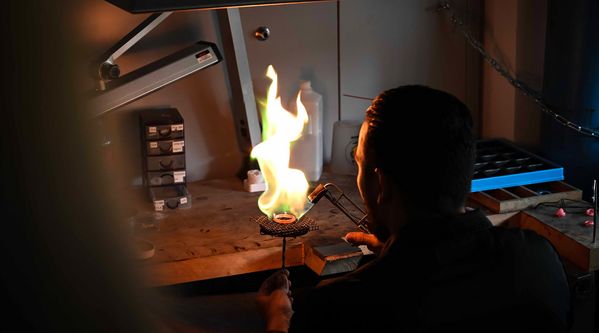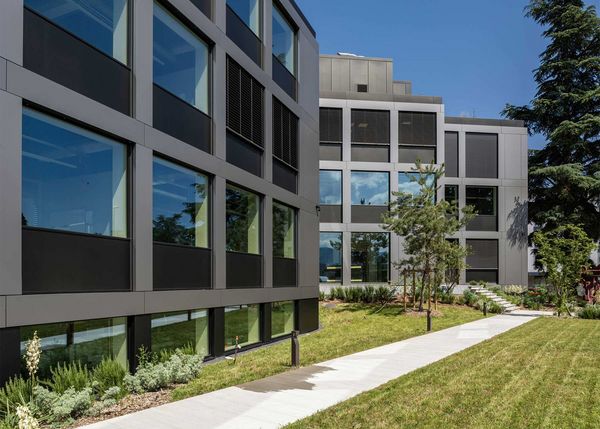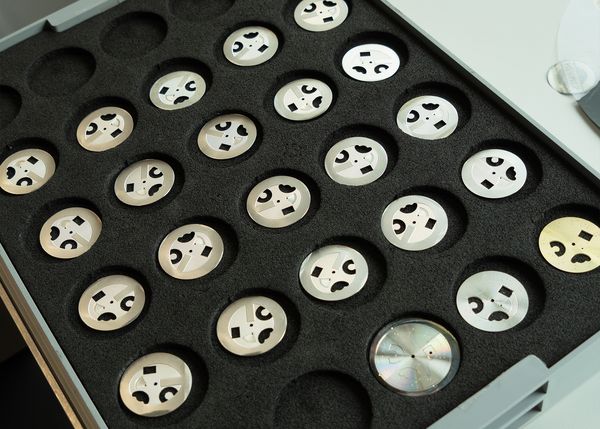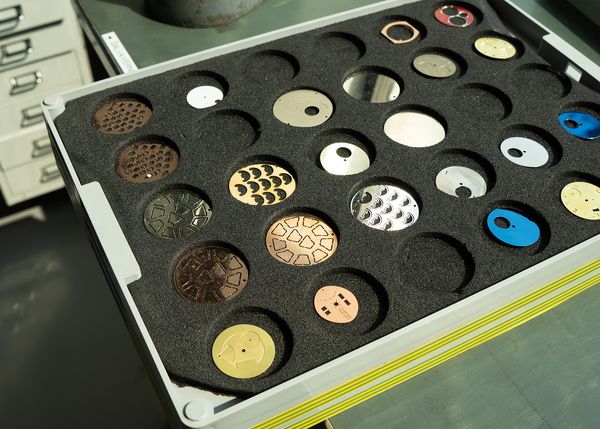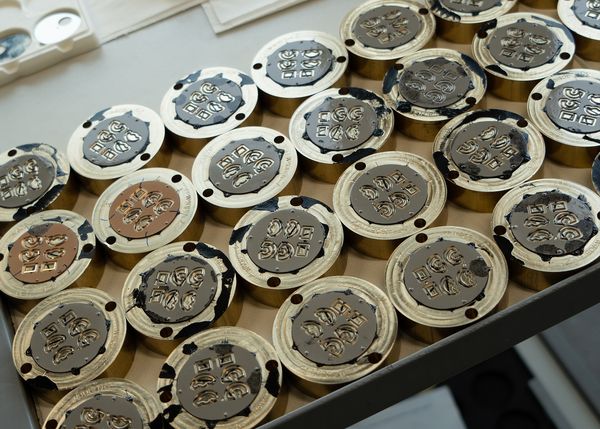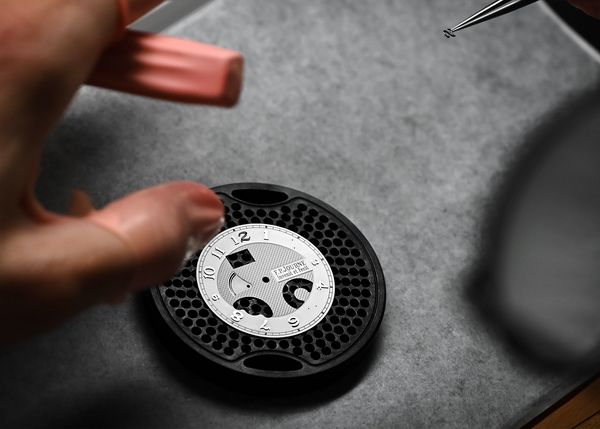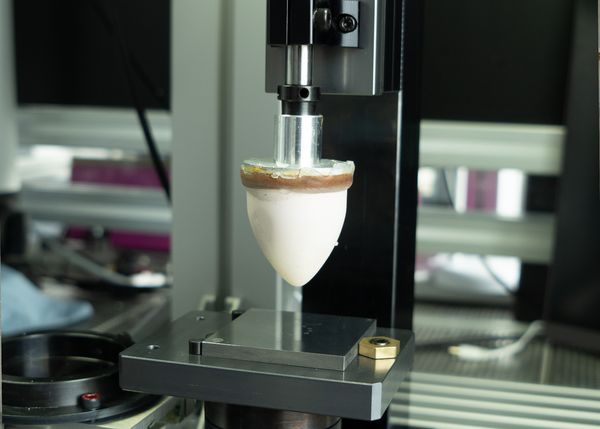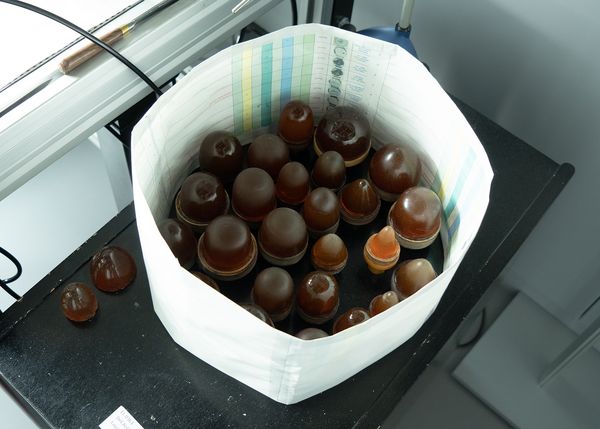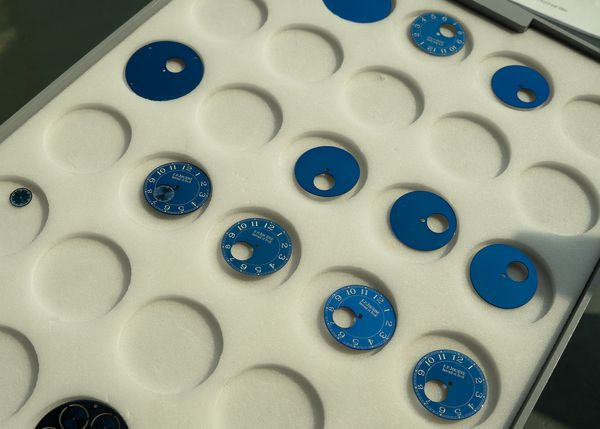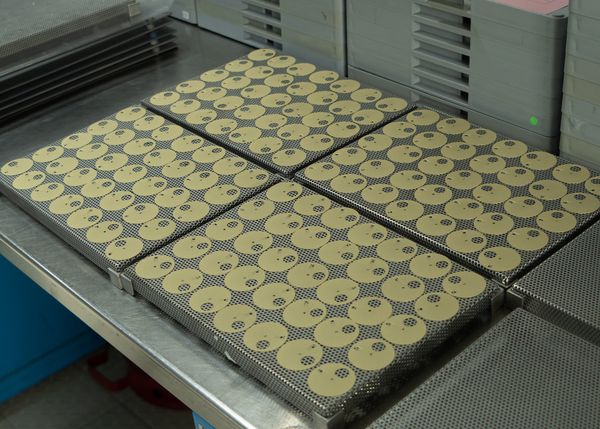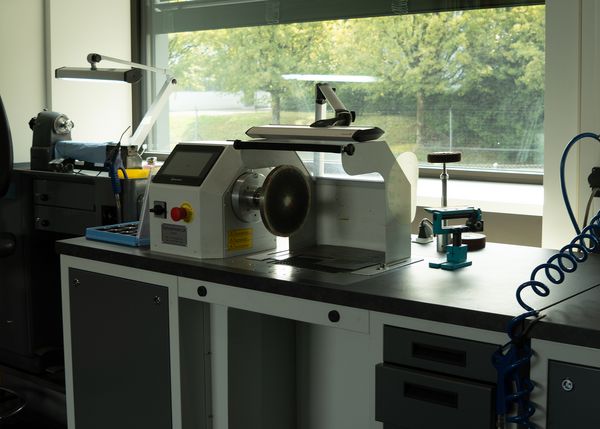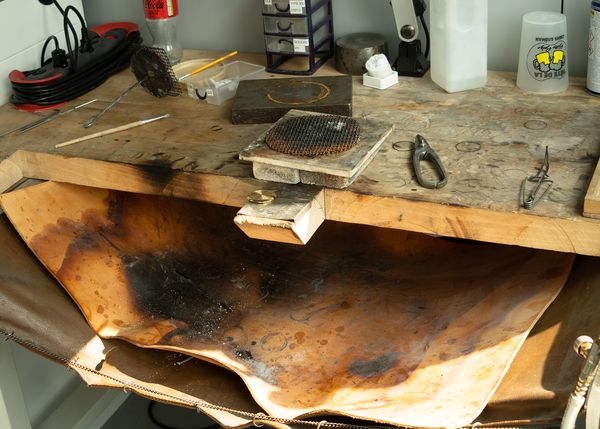– Text by Logan Baker; images by Logan Baker (unless noted)
F.P. Journe, the brand, turns 25 this year.
A lot has changed since Francois-Paul Journe inaugurated his company in 1999.
What hasn’t changed are the tensions that underline Journe’s watchmaking.
The 66-year-old Frenchman is widely considered the most influential individual in the contemporary independent watchmaking scene, a movement that prizes handcraft and a small-batch approach to production. Journe is a true student of watchmaking history, influenced by the great makers of the past like Jean-Antoine Lépine, Antide Janvier, and Abraham-Louis Breguet.
Yet Journe has also embraced industrial processes in a way that might seem opposed to traditional watchmaking. He’s a champion of contemporary production methods like CNC and CAD. He produces approximately 1,000 mechanical timepieces a year, far more than most of his contemporaries.
This tension, between modern technology and traditional handcraft, is at the heart of the Journe brand. You must understand old-world watchmaking ideals to truly appreciate an F.P. Journe watch, while understanding that it wouldn’t exist without Journe’s willingness to experiment with modern production techniques.
No where is the relationship between these two competing urges more apparent than at Les Cadraniers de Genève and Les Boîtiers de Genève, a pair of manufacturing facilities dedicated to case and dial production that are wholly owned by the F.P. Journe on the outskirts of Geneva, in the industrial neighborhood of Meyrin.
F.P. Journe’s headquarters remains in the heart of Geneva, Rue de l'Arquebuse, less than a 10-minute walk from Phillips’ office. This is where Journe works on a daily basis alongside his watchmakers and Journe’s movement components are fabricated. If you visit F.P. Journe in Geneva, this is likely where you’ll go.
Les Cadraniers de Genève and Les Boîtiers de Genève have been in Meyrin since 2012. We visited the dial making facility several years ago to document the restoration of a Patek Philippe Ref. 530. Since then, a brand-new, cutting-edge facility that houses both entities was opened in June 2023. F.P. Journe team was kind enough to invite me for a visit last fall.
This project began three years ago when F.P. Journe acquired an abandoned factory on rue de Veyrot in Meyrin. The building was stripped and rebuilt according to Journe’s precise specifications, which included the addition of a new floor and an enhanced climate control system that controls temperature and humidity, helping maintain quality control in dialmaking – not to mention some of the most elaborate security protocols I’ve seen implemented by any Swiss watchmaking operation.
Unlike most independent watchmakers that rely on a literal cottage industry of suppliers, F.P. Journe can claim that more than 95 percent of every watch they make is produced in-house, including dial, case, bracelet, and most movement components. The only things F.P. Journe doesn’t make (for now) include straps, springs, jewels, and parts of the escapement.
F.P. Journe employs approximately 150 people across its three Geneva entities, a massive operation that dwarfs the size of any other tradition-minded Swiss watchmaker. However, not everyone that works at Les Cadraniers de Genève is solely focused on F.P. Journe timepieces. The dialmaker is contracted by dozens of other watchmaking entities to produce exclusive dials on contract. Les Cadraniers de Genève is one of the most highly regarded dialmakers working at scale in Switzerland, alongside other prestigious operations such as Kari Voutilainen’s Comblémine, Ulysse Nardin’s Donzé Cadrans, and Parmigani’s Quadrance et Habillage, earning the F.P. Journe business additional profits.
F.P. Journe benefits from sole ownership of a dial- and a casemaker in many ways, particularly when it comes to quality control, supply chain management, and reducing external costs. Journe is able to avoid the production bottlenecks that so often delay the releases and delivery of watches by other brands, big and small.
Although they share the same building, Les Cadraniers de Genève and Les Boîtiers de Genève work completely separate from one another to isolate the manufacturing processes, specifically to protect the delicate surface of the in-progress dials from excess metal particulates introduced into the environment by the casemaking operation.
I was invited by the F.P. Journe team for a visit to the new-look Les Boîtiers de Genève and Les Cadraniers de Genève a few months ago. I’ve been fortunate to visit many different watchmaking operations over the past decade, from one-man, multi-lathe workshops to massive highly automated factories owned by multinational conglomerates. My experience at Journe’s new facilities surprised and impressed me in ways I didn’t expect.
Inside Les Cadraniers de Genève
Les Cadraniers de Genève is likely the more well-known concern among enthusiasts compared to its casemaking sibling, simply due to its position as a leading supplier of high-end watch dials to the rest of the Swiss industry.
The entity dates back to the earliest days of the F.P. Journe company. Although it’s not his individual specialty, Journe produced his own dials by hand for the souscription series of the Toubillon Souverain and Chronomètre à Résonance, and the pre-Souscription series of the Chronomètre à Résonance.
In need of dial production assistance without having to rely on the traditional Swiss supplier network, F.P. Journe teamed up with watchmaker Cédric Johner and jeweler Harry Winston (then under the leadership of Max Büsser) to create the first iteration of Les Cadraniers de Genève as a joint venture. Cedric Johner and Harry Winston eventually exited the company, leading the way for Vacheron Constantin to join Journe with an acquisition of 50 percent of the company.
Vacheron’s investment supported the creation of Les Cadraniers de Genève’s first facility in Meyrin, which opened in 2012. F.P. Journe bought out Vacheron Constantin in 2016, although the Richemont-owned brand remains a client of Les Cadraniers de Genève to this day. Today F.P. Journe is the sole owner of both Les Cadraniers de Genève and Les Boîtiers de Genève.
Les Cadraniers de Genève takes up the top two floors of the newly opened Meyrin facility, with more than 30 employees working in 13 separate workshops.
F.P. Journe insists that production of a new watch starts with the dial. For such a technical-focused brand, it’s surprising to learn that aesthetics informs so much of what Journe does. But it makes more sense once you consider that the company’s design department is a committee of one: Journe himself. After Journe comes up with a concept, the designs move to Les Cadraniers de Genève, where they’re recreated using CAD programs. Les Cadraniers de Genève has an R&D department exclusively dedicated to dial production.
Dials always start with raw material. Although F.P. Journe is famous for its use of dials crafted from solid red and white gold, they also utilize maillechort (German silver) and solid silver – that’s right, no brass here. CNC machines are used to cut the dial shape and drill holes that will later be used for various apertures (such as a date window) and the dial feet; notably, these holes are lightly beveled despite being behind the dial in a position that no owner will ever see.
After the dial has undergone this preliminary machining stage, it's checked by hand for flatness. This is a pivotal process that is repeated multiple times throughout the production lifecycle of every dial. Dials can accidentally bend or become distorted at any point throughout the manufacturing process, but the final product must be perfectly flat for additional dial components to be added, as well as so the handset can function properly. F.P. Journe dials are also remarkably thin, with a miniscule tolerance between 0.2 and 0.4 millimeters in height. Dial flatness must be checked by hand at F.P. Journe as there are no existing machines that can check flatness to the degree desired by Journe. If any machining burrs are detected, they’re delicately shaved off before the dial moves on to its next phase.
The appliqué department also requires a surprising amount of work. Each applied element, ranging from hour numerals to various frames for complications and timing displays), are milled using CNC machines before undergoing a high degree of mirror-polishing using a manually operated lathe.
Arguably the most impressive process I witnessed came in the décalque workshop, where pad printing (tampographie) for thw dials is handled. A specialist uses a transfer pad to print painted text on the dials; there are at least five to six layers of paint on every dial. Any excess paint is delicately removed using a scalpel-like blade.
Of the two work stations I saw in this area, one was set up with a silicone mold, while the other utilized molds made of natural gelatin. I was told that the latter molds are made by a single individual who has worked with F.P. Journe since 2000. I was told that this man, who started his career at Stern Frères more than 40 years ago, has overseen the dial pad printing on every single F.P. Journe watch to date.
Various dial finishing techniques also have dedicated workshops in Les Cadraniers de Genève. Some are simpler, such as satin finishing (done by hand) and sandblasting (used for the dials of the LineSport collection), while others are more intricate, such as the lacquered dial of the Chronomètre Bleu. The Chronomètre Bleu's dial receives multiple layers of blue lacquer, with each layer being polished via hand-operated lathe before before and after. The dials are also baked in an oven multiple times throughout this process to ensure the lacquer coating solidifies. Chronomètre Bleu dials are the toughest dials regularly produced by Les Cadraniers de Genève, with a success rate between 15 and 20 percent. F.P. Journe currently produces approximately 50 Chronomètre Bleu examples per year, down from a high of 200 per annum from a few years ago.
The polishing stage is carried out before the lacquering phases, at the very beginning, and afterwards, for the final finish.
Another finishing technique Les Cadraniers de Genève specializes in is enameling, despite the fact that the only current F.P. Journe timepiece with an enamel dial is the primary timekeeping display on the current-generation Tourbillon Souverain (and the one-of-a-kind Chronomètre Furtif Bleu). In this department I saw grand feu enamel dials being created for a number of high-end brands, ranging from small-batch independent makers to large-scale conglomerate-owned brands. I was particularly impressed by the large wall of enamel powder the enamel artisans had available, with what looked like hundreds of color options to choose from. Although the enameling department is currently focused mainly on working for outside brands, it was hinted to me that we'll likely see more enamel dials on F.P. Journe watches in the future.
One of the final workshops is dedicated to galvanoplastie, or electroplating, where a thin layer of metal is deposited on the surface of a dial using an electric current. Dials are effectively "cooked" inside a liquid vat for a specific amount of time to achieve the desired color and texture. Journe's team of chemists knows exactly how long a dial needs to be in the vat to achieve an indistinguishable color/finish across various models.
The Assembly workshop is where final construction takes place. This is where the different appliques are individually attached to each dial, and final quality control takes place. This is also where speciality dials are crafted out of delicate materials such as mother-of-pearl and hardstone (Journe has used jade and ruby in the past), using CNC machines to cut extremely thin layers of the material before being polished by lathe.
A final Les Cadraniers de Genève department is dedicated to restoration, a throwback to Journe's early career as a restorationist. Individual collectors and major brands will work with this department on restoration of vintage, museum-grade timepieces, with specific attention and respect paid to the original dial's existing condition.
Every aspect of dial creation and manufacturing takes place inside Les Cadraniers de Genève. Once a dial is deemed complete, it's sent to F.P. Journe's main facility in Geneva proper to be paired and assembled with a watch.
Inside Les Boîtiers de Genève
Les Boîtiers de Genève joined the F.P. Journe family later in the brand's story, officially opening its doors in 2012, although F.P. Journe already had shares in a former company that manufactured his cases. Unlike Les Cadraniers de Genève, Les Boîtiers de Genève has no outside clients, working exclusively on the production of F.P. Journe cases and bracelets.
Les Boîtiers de Genève currently produces cases and bracelets in platinum, gold (typically red/pink gold, but very occasionally in white and yellow gold), titanium, and tantalum. Journe confirmed to me that platinum cases just barely overcomes gold in production quantities, followed by titanium (only used in the LineSport collection), and tantalum (currently only found in one production watch, the Chronomètre Bleu).
Inside Les Boîtiers de Genève, you’ll find seven different workshops solely focused on casemaking, starting at the bottom floor of the building where large, humming CNC machines used for milling the case and bracelets are located due to their immense weight. The raw material is formed into a rod/ingot using molds before being milled into the appropriate shape for an F.P. Journe case or bracelet. F.P. Journe cases typically use a three-piece construction consisting of a bezel, a case middle, and a caseback. The caseback is screwed to the case middle, while the bezel is soldered to it. Different F.P. Journe case designs necessitate different amounts of work; one example I was provided was the Astronomic Souveraine case, which requires the use of 48 different sets of tooling to cut and shape.
I'm fortunate that my position has allowed me to visit a significant number of watchmaking facilities. The areas dedicated to CNC milling, regardless of company or brand, are typically always the same. You start to recognize the same types of CNC machines at each facility, but Les Boîtiers de Genève was different. F.P. Journe had the most up-to-date, contemporary machines I've seen at any facility, even more modern than what I've seen at highly automated facilities for brands like Omega and Panerai. These new machines, bought specifically for the opening of the new Les Boîtiers de Genève in 2023, are able to craft components to an even higher degree of tolerance than similar machines a few years older.
The four case metals used by F.P. Journe all provide different challenges for the machinists. Tooling wears down based on the hardness quotient of each metal. Gold is relatively soft and doesn't provide many challenes, but the difficulty increases when you start working on things like platinum, titanium, and tantalum – the latter in particular.
It's not a very cost-effective process, which is the main reason why tantalum isn't a very common case material used in watchmaking. F.P. Journe is able to subsidize some of that cost by taking it in-house; it's unlikely a supplier would be willing to produce the 50 or so cases F.P. Journe uses every year in the Chronomètre Bleu, and even more unlikely a supplier would take on a project like the one-off case and bracelet used in the unique Chronomètre Furtif Bleu that was announced last year for (the since-delayed) Only Watch 2023 charity auction. F.P. Journe says the bracelet on this watch is the first known to be crafted entirely out of tantalum with no secondary metal (Audemars Piguet created a few bi-metal Royal Oak bracelets in the 1990s that used half tantalum paired with another metal). It's difficult to understate how time-consuming it must have been to mill every individual component on the flat-link bracelet.
The cases are all then polished by hand using a spinning polishing wheel to remove any excess burrs or marks left by the tooling. Most F.P. Journe watches are polished, save for the sandblasted finish found on the cases used in the LineSport and Élégante collection; certain Élégante models also feature a special oxidized titanium treatment called Titalyt. Naturally, polishing tantalum is an exceptionally difficult and time-intensive process.
The next workshop is dedicated exclusively to soldering and welding. Two methods are used: the traditional process involves heating the components with a large open flame, as well as a more high-tech approach using lasers. The latter is the most common technique used by Journe, making up close to 90 percent of Journe's production, while the traditional model with an open flame is only used on Journe's most complex case designs, such as the Astronomic Souveraine.
The cases go back to the finishing department for another round of mirror polishing at this point. LineSport and Élégante cases will then be separated to receive their sandblasting or beadblasting (satin) finish. Les Boîtiers de Genève also operates a dedicated ceramics workshop, where the bezels found on certain LineSport models are fired and crafted.
Lasers show up once more inside a room dedicated to engraving. This is where the engraving found on the caseback is handled. It's also where Journe's strap and bracelet buckles are engraved and finished after being milled in the machining department. These high-tech laser-welding machines can also be used to add material back to a case during a refinishing or restoration process.
One of the few outsourced processes Journe still relies on the outside world to achieve is gem-setting. Bejeweled F.P. Journe timepieces are still few and far between, typically only available on custom request, so Journe feels comfortable working with a top-of-the-line company on the process. Just like Les Cadraniers de Genève, Les Boîtiers de Genève has its own dedicated research and development department for case design and production.
F.P. Journe watches aren't typically associated with bracelets, and still today the majority of the brand's watches come paired with a leather strap. The LineSport models are unique in always coming on a titanium or gold bracelet; however, it's also possible to order a platinum or gold bracelet for models in the brand's current Classic collection, such as on the Chronomètre à Resonance and Tourbillon Souverain Vertical.
That said, F.P. Journe does produce every part of the bracelets it uses inside Les Boîtiers de Genève. Very few brands construct their bracelets in-house, instead relying on specialist suppliers. Bracelets can be a fickle construction process, involving a large number of components, and are something clients and collectors tend to focus on since they so closely relate to wearing comfort. As a result of owning the process at Les Boîtiers de Genève, Journe is able to control the quality of its bracelets to a higher degree than any similar sized brand, as well as many much larger ones. The bracelets and buckles all have their own established multi-step milling, finishing, and engraving process that's been developed by Journe and the Les Boîtiers de Genève team. I was told that the buckles, by themselves, utilize a 50-step process with multiple finishing techniques.
Analysis
F.P. Journe's ownership of Les Cadraniers de Genève and Les Boîtiers de Genève provide the brand a unique position in the watch world. I can't think of another brand that offers in-house cases and dials that so effectively blends state-of-the-art, automated machining with hand decoration and polishing. F.P. Journe's role as a dial supplier to the industry at large is also a testament to the company's singular and important position in the Swiss watchmaking ecosystem.
It allows F.P. Journe to experiment with unusual materials, like tantalum, while maintaining its core focus on traditional craftsmanship, keenly evident in the brand's complicated timepieces that few – if any – other brands dare attempt. Innovation and tradition exist in complete harmony, never superseding the other.
The example F.P. Journe's team likes to use is silicon. Brand all over the Swiss watchmaking spectrum rely on silicon technology in their movements, from Oris to Patek Philippe, but it's something F.P. Journe refuses to touch. It's a material that offers an intrinsic benefit in watchmaking, but it's also something that can never be repaired, only replaced. F.P. Journe wants his watches to be able to be repaired decades into the future, which is why he'll rely on automated machining processes that can still be repaired in the tradition way (such as CNC machines and laser engraving), but won't touch high-tech silicon technology. It's in this way that the modern innovations used by F.P. Journe serve his tradition perspective on watchmaking.
It's also important not to discount the financial investment Les Cadraniers de Genève and Les Boîtiers de Genève represent for the F.P. Journe brand. There's a reason most brands rely on suppliers. Buying state-of-the-art, brand-new CNC machines like the ones found at Les Cadraniers de Genève and Les Boîtiers de Genève are easily a seven-figure expensive. It's something that brands with annual production figures in the hundreds of thousands will balk at, so it's highly unusual to see it at a brand only making 1,000 watches a year. This sort of investment is something very few watchmakers are willing to make – but it speaks to Journe's commitment to independence that he's made it happen for his brand.
There is no really economical sense behind it. The only thing that makes sense is the leader that principal wants to have inside the best. Exactly that's the best and have the full ability to create whatever you want. It was quite difficult the previous year to have all the supplier was it was impossible to deliver and many, many brands have trouble to have movement to have components to everything. We were very affected by this because actually we have the production capacity and the capacity of manufacturer all, it's like 90% of all the components, cases, dials, and movements. So basically we do not depend on anyone else than us.
About Phillips In Association With Bacs & Russo
The team of specialists at PHILLIPS Watches is dedicated to an uncompromised approach to quality, transparency, and client service. Phillips in Association with Bacs & Russo holds the world record for the most successful watch auction, with its Geneva Watch Auction: XIV having realized $74.5 million in 2021. Over the course of 2021 and 2022, the company sold 100% of the watches offered, a first in the industry, resulting in the highest annual total in history across all the auction houses at $227 million.
About Logan Baker
Logan has spent the past decade reporting on every aspect of the watch business. He joined Phillips in Association with Bacs & Russo at the start of 2023 as the department's Senior Editorial Manager. He splits his time between New York and Geneva.
Recommended Reading
Four Pivotal Ingredients Behind F.P. Journe's Booming Popularity
Looking For A Rare F.P. Journe? Try One With A Black Or Grey Dial
The Remarkable True Story Behind Why F.P. Journe Abandoned The 38mm Case Size
